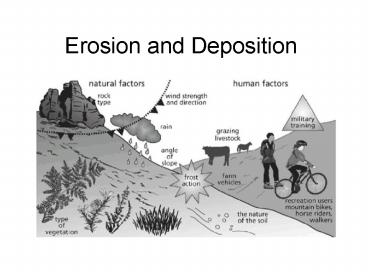Erosion and Deposition - PowerPoint PPT Presentation
1 / 27
Title: Erosion and Deposition
1
Erosion and Deposition
2
Two Important Definitions
- Erosion the removal of weathered rock and soil
from its original location - Deposition the dropping of eroded material in a
different location (when you make a deposit at
the bank you are leaving money here rock is
deposited in a new place)
3
Gravity
- The power behind most erosional agents
- Rock is pulled downslope by the force of gravity
4
4 Types of Erosion
- Erosion by Water
- Erosion by Glacier
- Erosion by Wind
- Erosion by Living Things
5
1. Erosion by Water
- Rill Erosion when a narrow stream cuts a small
channel into the land (think narrow stream) - Gully Erosion stream of water has gone beyond
Rill Erosion and now the stream of water is deep
and wide (think wider stream)
6
1. Erosion by Water- Rivers and Streams
- Each year streams carry billions of metric tons
of sediments and weathered material to the
coastal areas - Over time, the build up of sediment produces
deltas (example Colorado River Delta-right
Mississippi River Delta - left)
7
1. Erosion by Water- Waves
- Sand on an ocean shoreline is repeatedly picked
up, moved, and deposited - Constant movement of water is a continuous
erosional process - Deposits can lead to sand bars and barrier
islands (example Outer Banks of N.Carolina)
8
2. Glacial Erosion
- Currently cover 10 of the Earths surface
- Once covered 30
- Scraping and gouging the earth as they move huge
rock and piles of debris over great distances - Glacial movements scratch and grind surfaces and
deposit material over long distances
9
(No Transcript)
10
3. Wind Erosion
- Moves fine, dry particles a great distance
- Most common in areas without vegetation holding
the soil into places - Can be prevented with a wind barrier (stand of
trees or other vegetation planted perpendicular
to the direction of the wind)
11
(No Transcript)
12
4. Erosion by Living Things
- Examples of Erosion by living things
- Excavating land
- Planting a garden
- Developing land
- Building a highway
- All of these can lead to erosion
13
(No Transcript)
14
Mass Movement
- Downslope moving of soil and weathered rock
resulting from the force of gravity - ALL mass movements occur on slopes
15
Factors that Influence Mass Movement
- Materials weight
- Materials resistance to sliding or flowing
- Trigger (like at earthquake)
- Water
16
Classification of Mass Movement
- Creep slow, steady downflow of loose weathered
material - a) slowly creep can cause once vertical utility
poles and fences to tilt
17
(No Transcript)
18
- 2) Flows slow movements of soil
- a) mudflows swiftly moving mixtures of mud
and water
19
Mudflow
- http//www.youtube.com/watch?vn1cCs-S5EKc
20
(No Transcript)
21
- 3) Slides top layers of soil are thin and move
downslope rapidly - a) Landslides
- b) Slumps (landslide on a curved surface)
- c) Avalanche (snow melts in sun, refreezes at
night and the fallen snow moves downslope)
22
Avalanche
- http//www.youtube.com/watch?v99j17GL3qlE
23
(No Transcript)
24
- 4) Rockfalls rocks are loosened by physical
weathering, - they then break loose and fall downslope
- a) less likely in humid climates where a layer of
soil and vegetation cover the rock
25
Rock fall
- http//www.youtube.com/watch?vZVYGJYnJTi0
26
(No Transcript)
27
People
- Humans can minimize the destruction caused by
mass movement by not building near the base of
unstable slopes - gt25o slopes are at the greatest risk of a
catastrophic mass movement































